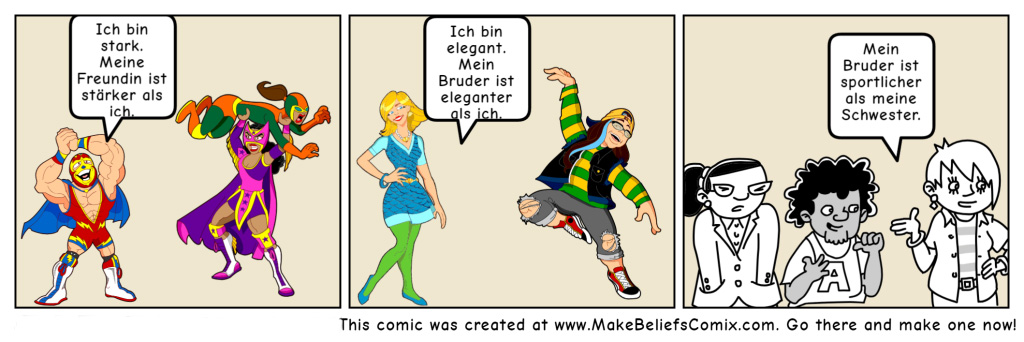3.2 Eigenschaften und Gegensätze

Grüß Gott!
Zum Aufwärmen machen wir unseren Tagesminiplausch und eine Wiederholung.
Wiederholung

Jetzt bist du dran!
Wer ist lustig? Who is funny? Do you have anyone in your family who is funny? Go through your closest family members and write in your journal whether they are funny (or not!). Use Julia’s example as your model: Meine Mutter ist ein lustiger Mensch. Mein Vater ist kein lustiger Mensch. Aber meine Schwester ist auch eine lustige Person. Und mein Bruder ist keine lustige Person.
Lektionsüberblick
In this lesson, you will expand your ability to describe another person’s characteristics (Eigenschaften), words that describe how a person is. In the end, you will be able to 1) identify opposite pairs of characteristics, 2) talk about your family member’s characteristics, and 3) compare family members through more/less.
Was weißt du schon?
| Noch nicht start klar?
Du kannst immer auf die gleiche 1010-Lektion zurückgreifen! |
Not confident about starting this lesson?
You can always review the same Lektion from 1010. |
1) Identify opposite pairs of characteristics
As you might remember, there are a couple of ways to say the opposite of a characteristic in German. This is true in English too! Think: He is not intelligent. He is unintelligent.
In the previous exercise, we looked at ways to say essentially the same thing. Now let’s focus on true opposites. Using the process of elimination and what you know about cognates, complete the activity below.
Köln im Blickpunkt

Der Kölner Straßenkarneval ist ein großes Fest in Köln, das jedes Jahr im Februar oder März stattfindet. Die Menschen verkleiden sich in bunten Kostümen, feiern auf den Straßen, tanzen und singen. Während des Karnevals werden mehr als 150 Millionen Gläser Kölsch getrunken, weil Besucher aus ganz Deutschland und der Welt nach Köln kommen, um mitzufeiern.
The Cologne Street Carnival is a major festival in Cologne that takes place every year in February or March. People dress up in colorful costumes and celebrate in the streets, dancing and singing. During Carnival, more than 150 million glasses of Kölsch beer are consumed, as visitors from all over Germany and around the world come to Cologne to join in the festivities.
Jetzt bist du dran!
Wie bist du? Wie ist dein Bruder? What are you like? What is your brother like? Consider the adjectives from this lesson so far. Pick several that describe you and your favorite family member and several that describe the opposite and write about yourself and your favorite family member. Challenge yourself and think through the different ways of saying opposites.
Use Julia’s example as a model: Ich bin fleißig, freundlich und extrovertiert. Also bin ich nicht faul, nicht unfreundlich und introvertiert. Mein Bruder ist ungeduldig, faul und intelligent. Also ist er nicht geduldig, nicht fleißig und nicht dumm.
Do you see how she stated three characteristics and then restated them in different ways of using opposites (nicht, un-, and the opposite word)? Try it! Remember, the more you repeat, the more you will remember.
When you are ready, record your descriptions aloud in your audio journal. Rerecord until you are satisfied.
2) Über die Familie sprechen
Consider the characteristic faul (lazy). You’ve learned that you can place the word nicht in front of the adjective or characteristic to indicate the opposite of that adjective.
Can you tell from the images what the other words in front of the word faul mean?
| sehr faul | ein bißchen faul/etwas faul | gar nicht faul |
 |
 |
 |
Jetzt bist du dran!
Wie intelligent ist deine Mutter oder dein Vater? Oder, deine Geschwister? Pick a family member and some of the descriptors we covered so far and write to which degree (nicht, gar nicht, etwas/ein bißchen, and sehr) that family member is (or is not) that way.
Once again, use Julia’s example as a model: Mein Bruder ist sehr ungeduldig, etwas faul und gar nicht dumm. If you want more practice, add a second family member who is different from your first, and write out sentences of descriptions.
3) Familienmitglieder vergleichen
You have some experience making comparisons in German. Think: Ich bin älter als mein Bruder.
Read and listen to the comic below.
 |
||
Jetzt bist du dran!
Zum Schluß
In this lesson, you learned how toto 1) identify opposite pairs of characteristics, 2) talk about your family member’s characteristics, and 3) compare family members through more/less. If you are feeling unsure about any part of today’s lesson, go back to that section and review.
Let’s combine it all! Pick 2-3 family members and compare them to you and to each other – also using the words that mark the intensity of a characteristic. Use Julia’s example as a model:

*As you conclude this lesson, don’t forget to check Canvas!*

Media Attributions
- 3.1-ii-Mein-Vater-ist-comic © This comic strip was generated at http://www.MakeBeliefsComix.com. Used by permission of author and site creator Bill Zimmerman.
- Photo of Rosenmontag by Gudrun Velten, Wikipedia
- Photo of lazy dog by pexels-1948912-3609067
- Photo of retriever by pexels-jmeyer1220-752389
- Photo of man and dog by pexels-zen-chung-5745228
- 3.2 comic comparison © This comic strip was generated at http://www.MakeBeliefsComix.com. Used by permission of author and site creator Bill Zimmerman.

